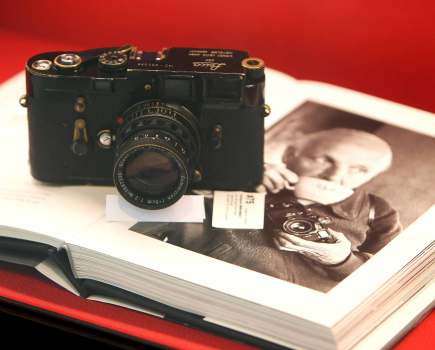Photo Insight with Jim Brandenburg

For more than 30 years, Jim Brandenburg travelled the world as a photographer with National Geographic magazine. His work has been published in The New York Times, Life and Time, among others, and he has won numerous awards, including Kodak Wildlife Photographer of the Year by the Natural History Museum and BBC Wildlife Magazine. He is the chair of this year’s competition. Every month Jim will share the story behind one of his nature images
This image was taken within the past two years during a visit to Brittany in the north-west of France. The birds you see here are avocets. It’s not immediately obvious what this shot is trying to show. I don’t mean it’s confusing, but that you need to really focus in on it and consider what you’re seeing. That’s a nice element of this image. It requires repeated viewings to truly appreciate what’s going on, but once you have it you’re still drawn into the graphic nature of the birds’ formation.
This is an image that is very much about form. At first the cluster of birds looks almost like a puzzle. Shooting images like this is a technique that I often employ to arrest the viewer’s attention, as well as my own. This goes way back to my days as a painter, where I would never paint my subject in a literal light – there was always some kind of an abstract element. That’s something I like to achieve through my use of a camera.
With this in mind, there are two levels to this image. You have the graphic formation – the shape – and then you have the fact that they are black & white birds against a white sky, which gives nice contrast. It was shot using a Nikon D3S and 500mm lens.
I’ve talked before about how some of my best shots have been a matter of luck. Sometimes I’ll find myself in a position where all the elements align to give me the perfect image. Often this occurs in just a matter of seconds, and if I delay I’ll miss the shot and never be able to get it. This was most definitely not one of those occasions. It was an absolutely terrible day to shoot as the weather was miserable. I thought it was going to be impossible to get a picture. All I could do was just shoot and shoot. I actually took a number of shots to get this image, although I didn’t realise I had it at the time.
During the editing stages, I happened upon this one image that held my eye. The more I looked at it, the more it engaged me. Once I’d added a little contrast in Photoshop, I knew I had the image I’d been looking for.

There are very few pictures that I’ve shot in my 40-year career where I’ve fired the shutter and known that I had something in the bag. There have been a few, of course, but more often than not my best shots are a surprise. That’s one of the most exciting things about photography. It’s rare that you fully appreciate what you have until the editing stages. I was looking for the perfect shape and in that group of shots I managed to find this one that did everything I wanted it to.
Even with all the experience that I have as wildlife photographer, and as someone who has spent their entire life around nature, sights like bird formations still carry an air of mystery. That synchronisation is such a fine-tuned instinct and I’m still in awe of it.
As I’ve said before in previous Photo Insights, I’m a regular judge on the Veolia Environnement Wildlife Photographer of the Year competition. Year after year we receive these mind-blowing images of synchronised bird flight, often featuring starlings. That’s particularly intriguing to me because we don’t have these birds in the US where I live. The starlings come together and fly into ball formations. It’s remarkable and there truly is nothing else like it. Perhaps the closest equivalent you’ll find is fish shoaling. I’ve never been fortunate enough to see a synchronised starling flight in person, but I understand it’s a breathtaking spectacle.
The majority of my shots have dealt with the idea of minimalism. I’ve worked with that idea for so long that it’s an intuitive process now. In some ways I feel that I do my best work when I think about it the least. That’s an idea that largely stems from the influence of a more Eastern way of thinking. In Japan, the famous calligraphers will sit in front of a blank sheet of paper and with one broad stroke of the pen or brush they will create a work of art. They don’t explain it – they just do it. It’s very Zen.
People sometimes observe that there’s a clear Eastern influence running through my work and that’s incredibly important to me. I’ve spent a great deal of time in Japan. I’m very heavily influenced by Japanese minimalism and have studied the Japanese aesthetic for many years. It’s not just visual – it’s emotional and philosophical. It’s something that influences a lot of what I do and it has taught me to work on a subconscious and instinctual level. I owe a lot to that way of thinking.
Jim Brandenburg was talking to Oliver Atwell
To see more of Jim’s images visit www.jimbrandenburg.com







